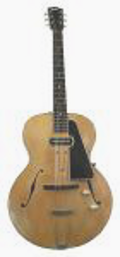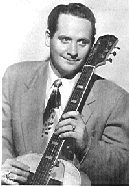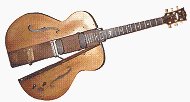Electric Guitar History
The Solid Body Electric Guitar Is Born
Gibson ES 335

As we mentioned, the next necessary step in electric guitar history was figuring out a way to
eliminate or at least control resonance, overtones and feedback. Many guitar manufacturers such
as Gibson, Gretsch, Epiphone and Rickenbacker produced semi-hollow body guitars to aid in combatting
the problems. These guitars had various configurations.
Some, like the Gibson ES 335, had a solid center
block running the length of the body of the guitar. Others had chambered bodies in which chambers are hollowed
out in the body of the guitar. The semi-acoustics, as they're known, can produce a full and rich tone but are
still prone, although to a lesser degree, to the same problems with feedback, high gain distortion, etc. that their
cousins, the electric acoustics, are.
Enter the Solid Body Electric Guitar...
By the late 1940's the electric guitar had established itself as
as an essential instrument in the music of the era. It had proven
itself to be a formidable instrument capable both of rhythmic excellence
as well being a fantastic melody maker and solo instrument. The resonance
problems had yet to be solved, though.
This brings us to two of the most important figures in electric guitar history - Les Paul
and Leo Fender.
Les Paul

Les Paul, a prominent Jazz musician and inventor, was convinced that a solid body electric guitar
was the answer to the resonance problems. In order to prove that his idea was the solution, another
piece of electric guitar history came into being. Paul created what he dubbed "The Log", which was
essentially a 4X4 piece of pinewood fitted with two pickups. Spectators were less than enamoured
of the "Log's" looks so Paul glued two cutaway halves of an acoustic guitar body to it to make it look like a
guitar.
The Log

The Log turned out to be a great sounding Jazz guitar without the unwanted feedback and overtones
that the hollow bodied electric guitars had. In 1946, Paul took his new guitar to Gibson. Gibson,
however, was not enthusaist about the idea of a solid bodied electric guitar. Previous attempts to
produce and market a solid body electric guitar had failed and Gibson believed that consumers would
still not accept the idea. Now it was time for Leo Fender to take his place in the history of the electric guitar.











New! Comments
Have your say about what you just read! Leave me a comment in the box below.